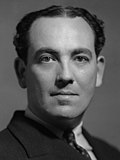This article needs additional citations for verification. (September 2024) |
The 1942 Maldon by-election was a parliamentary by-election held on 25 June 1942 for the British House of Commons constituency of Maldon in Essex. It was one a series of by-elections in World War II won by radical independent candidates.
| |||||||||||||||||||||||||||||
Constituency of Maldon | |||||||||||||||||||||||||||||
|---|---|---|---|---|---|---|---|---|---|---|---|---|---|---|---|---|---|---|---|---|---|---|---|---|---|---|---|---|---|
| Turnout | 44.4% ( | ||||||||||||||||||||||||||||
| |||||||||||||||||||||||||||||
| |||||||||||||||||||||||||||||
Previous MP
editThe seat had become vacant when the constituency's Conservative Member of Parliament (MP), Sir Edward Ruggles-Brise, had died on 12 May, aged 59. He had been Maldon's MP since the 1922 general election, with a brief interruption from 1923 to 1924.
Candidates
editDuring World War II, unopposed by-elections were common, since the major parties had agreed not to contest by-elections when vacancies arose in seats held by the other parties; contests occurred only when independent candidates or minor parties chose to stand.
The Conservative candidate in Maldon, R. J. Hunt, thus faced neither a Labour Party nor a Liberal candidate. However, the left-wing journalist Tom Driberg stood as an "Independent Labour" candidate. Driberg was well known as the Daily Express columnist "William Hickey" and had a home in Bradwell-on-Sea – the only candidate who lived in the constituency. He was a member of the "1941 Committee", a group of progressive intellectuals who met under the chairmanship of J. B. Priestley at the home of Edward G. Hulton, the owner of the Picture Post newspaper. At the start of May, the committee had published a "Nine-Point Plan" calling for works councils and the publication of "post-war plans for the provision of full and free education, employment and a civilized standard of living for everyone."[1] The plan formed the basis of Driberg's campaign.
The third contestant was 64-year-old[2] Borlase Matthews, standing as a National Independent and Agricultural candidate. He was Liberal candidate at Henley in the 1931 general election, in the 1932 Henley by-election, at Ashford for the 1935 general election,[3] and at the 1937 Tonbridge by-election. He was an engineer but left engineering to take up farming. He was a Member of the Council of the Royal Agricultural Society. He was a Member of the Electricity Commissioners Rural Electrification Conference. He was Chairman of the Rural Reconstruction Association. He was also an author of several books and papers on farming.[4] Matthews supported Churchill's Coalition government but felt that it was too dominated by the Conservatives and wanted it to be more progressive in nature.[5]
Results
editOn a much-reduced turnout, the result was a massive victory for Driberg, who won 61.3% of the votes. Ruggles-Brise had held the seat at the 1935 general election with 53.4% of the votes, a majority of 24.5%; but Hunt won only 31.3%.
Driberg sat as an Independent Labour MP until January 1945, when he took the Labour Whip in the House of Commons. As a Labour Party candidate, he held the seat comfortably at the 1945 general election, and remained Maldon's MP until he stepped down at the 1955 election.
The rejection of the government candidate was widely linked to the Axis capture of Tobruk only a few days beforehand, the latest in a string of British defeats, although Driberg denied that this had been a major factor.[6]
Votes
edit| Party | Candidate | Votes | % | ±% | |
|---|---|---|---|---|---|
| Conservative | Edward Ruggles-Brise | 17,072 | 53.4 | −17.4 | |
| Labour | W. F. Toynbee | 9,264 | 28.9 | −0.3 | |
| Liberal | Hilda Buckmaster | 5,680 | 17.7 | New | |
| Majority | 7,808 | 24.5 | −16.1 | ||
| Turnout | 32,016 | 73.8 | −0.9 | ||
| Conservative hold | Swing | ||||
| Party | Candidate | Votes | % | ±% | |
|---|---|---|---|---|---|
| Independent Labour | Tom Driberg | 12,219 | 61.3 | New | |
| Conservative | R. J. Hunt | 6,226 | 31.3 | −22.1 | |
| National Independent and Agricultural | Richard Borlase Matthews | 1,476 | 7.4 | New | |
| Majority | 5,993 | 30.0 | N/A | ||
| Turnout | 19,921 | 44.4 | −29.4 | ||
| Independent Labour gain from Conservative | Swing | ||||
| Party | Candidate | Votes | % | ±% | |
|---|---|---|---|---|---|
| Labour | Tom Driberg | 22,480 | 60.4 | −0.9 | |
| Conservative | Melford Stevenson | 14,753 | 39.6 | +6.3 | |
| Majority | 7,727 | 20.8 | −9.2 | ||
| Turnout | 37,233 | 74.5 | +30.1 | ||
| Labour gain from Independent Labour | Swing | ||||
See also
editReferences
edit- ^ Schoolnet: Tom Hopkinson Archived 6 February 2007 at the Wayback Machine
- ^ Who's Who in Engineering, 1921
- ^ The Times House of Commons, 1935
- ^ The Times House of Commons, 1931
- ^ Tom Driberg: his life and indiscretions, Francis Wheen
- ^ Cook, Chris; Ramsden, John, eds. (1997). By-Elections in British Politics. London: Routledge. p. 138. ISBN 978-1-85728-535-2.
- Craig, F. W. S. (1983) [1969]. British parliamentary election results 1918–1949 (3rd ed.). Chichester: Parliamentary Research Services. ISBN 0-900178-06-X.
- Leigh Rayment's Historical List of MPs

